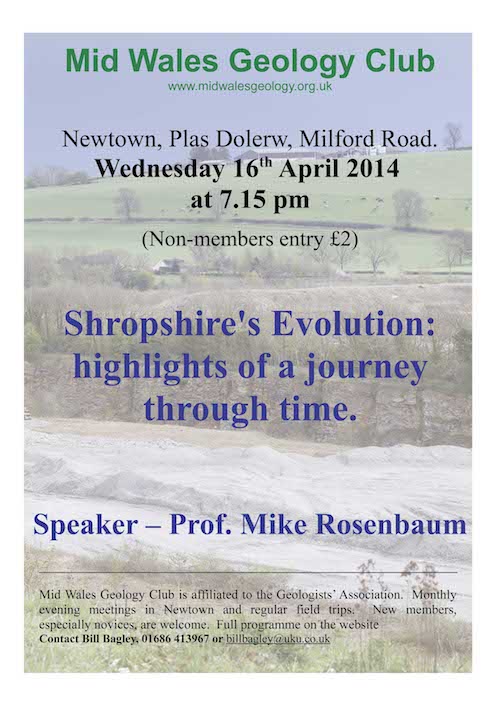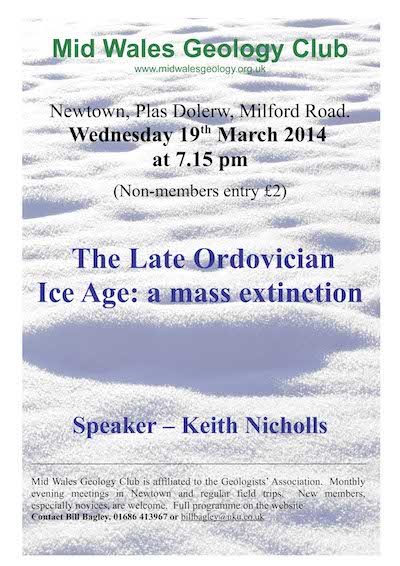Friday 18th April 2014
Rocks of the Elan Valley Reservoirs
Sunday 28 April 2013 (leader: Colin Humphrey)
Next field trip will be Sunday 28 April. Gather at 10.30 am, car park at Visitor Centre, Elan Valley, Rhayader LD6 5HP (SN 928 647). Driving south on the A470 to Rhayader, turn right at the crossroads and stay on the B4518 for 3½ miles. Bring a packed lunch. Hard hat not essential but advisable if you wish to approach close to rock faces. We aim to return to the visitor centre by around 3 pm (toilets at visitor centre and lunchtime at Claerwen dam). The localities examined lie on or near a single five mile stretch of quiet reservoir road between Caban Coch and Claerwen dams, so we will move mostly by car; the walking is easy.
The roads which wind around the exceptionally beautiful and peaceful reservoirs of the Elan and Claerwen valleys reveal the Cerigwynion Grits which ended the Ordovician here, and the mudstones which began the Silurian. Rising and falling sea-level 440 million years ago produced a range of different types of deep-water sediment deposition. This sandstone and mudstone succession was deposited as a series of gently sloping lobes with slumps, debris flows and a wide range of turbidites. An unusual feature is the record of a very different depositional environment, the Caban Conglomerates, an erosive high energy submarine channel flow which cut through the sandstone/mudstone slope-apron and left its own story in the rock. Local folding (Rhiwnant Anticline) followed by natural erosion and man’s rock cutting and has left different rock facies conveniently juxtaposed.
Thursday 3rd April 2014
The next indoor meeting will be on Wednesday 16th April 2014 when Professor Mike Rosenbaum will give talk entitled “Shropshire’s Evolution: highlights of a journey through time.”

Thursday 27th March 2014
Keith Nicholls gave a very interesting talk based upon the research he is undertaking for his PhD. The focus of his research being the glaciation and subsequent extinction event during the Hirnantian Epoch of the Ordovician Period.
The late Ordovician extinction event is one of the five great extinctions in the geological record and is thought to have occurred in two phases 0.5-1 million years apart. The first phase at the beginning of the Hirnantian was closely correlated with the onset of glaciation due to the increase in the Gondwana ice cap which led to a fall in sea level whilst the second phase is correlated with a decrease in glaciation and subsequent rise in sea level.
His work focuses on paleoecology,sedimentology, sequence stratigraphy and stable isotope studies of the rocks in North wales. Using his research, and that from around the world, it has been shown that there was a large positive 13C excursion which suggests a global disturbance in carbon cycling. Also there was a parallel positive excursion in 18O suggesting evidence of cooling an/or ice sheet growth. Even so this area of research remains controversial.
The next indoor meeting will be held on Wednesday 16th April with a talk by Professor Mike Rosenbaum entitled: Shropshire’s Evolution: highlights of a journey through time.
Sunday 9th March 2014
Our next talk will be on Wednesday the 19th of March, on “The Late Ordovician Ice Age: A Mass Extinction” by speaker Keith Nicholls.

Wednesday 26th February 2014
At the last meeting we heard a superb talk by Dr Geoff Steele on the origins of life.
Even the oldest rocks on Earth have traces of life. They date from the early Archaen, about 3.8 billion years ago. Hence to search for life’s origins we are forced back into the Hadean. The name means “Hell” and it‘s a good description. Huge volcanic eruptions, burning ultraviolet radiation, noxious gases, enormous tides and constant bombardment by meteorites and comets do not sound like a good place to start.
No fossils survive from the Hadean. But the biochemistry of our own cells, and that of all other living organisms, preserves a remarkable record of our earliest times. It has given us a new kind of fossil hunting. In particular the DNA and RNA that store and manipulate our genes can be read like a book, complete with the copying errors and editing errors that tell so much about previous owners. They prove to us that all life on Earth is indeed related, as Charles Darwin proposed, and even allow a reasonable reconstruction of our common ancestor (a simple prokaryote). But where did that come from?
If our quest is the origin of life then we need to think carefully about what we’re looking for. What exactly is life? How is it defined? It seems that replication and metabolism are the minimum requirements, and if they are confined within an enclosed space such as a membrane then that object is perhaps “living”. Could such a thing have formed naturally in Hell? Research suggests that the conditions were right for RNA molecules to form. And they can act as both genes and enzymes giving both replication and metabolism. Hence the simplest life may have begun with just RNA, wrapped in the lipid membranes that form naturally when oil and water are shaken together. And it is astonishing to discover that one of our most basic enzymes, crucial to all modern life, appears to be a living fossil from that time.
The next meeting will be held on Wednesday 19th March when Keith Nicholls will give a talk entitled “The Late Ordovician Ice Age: a mass extinction”

